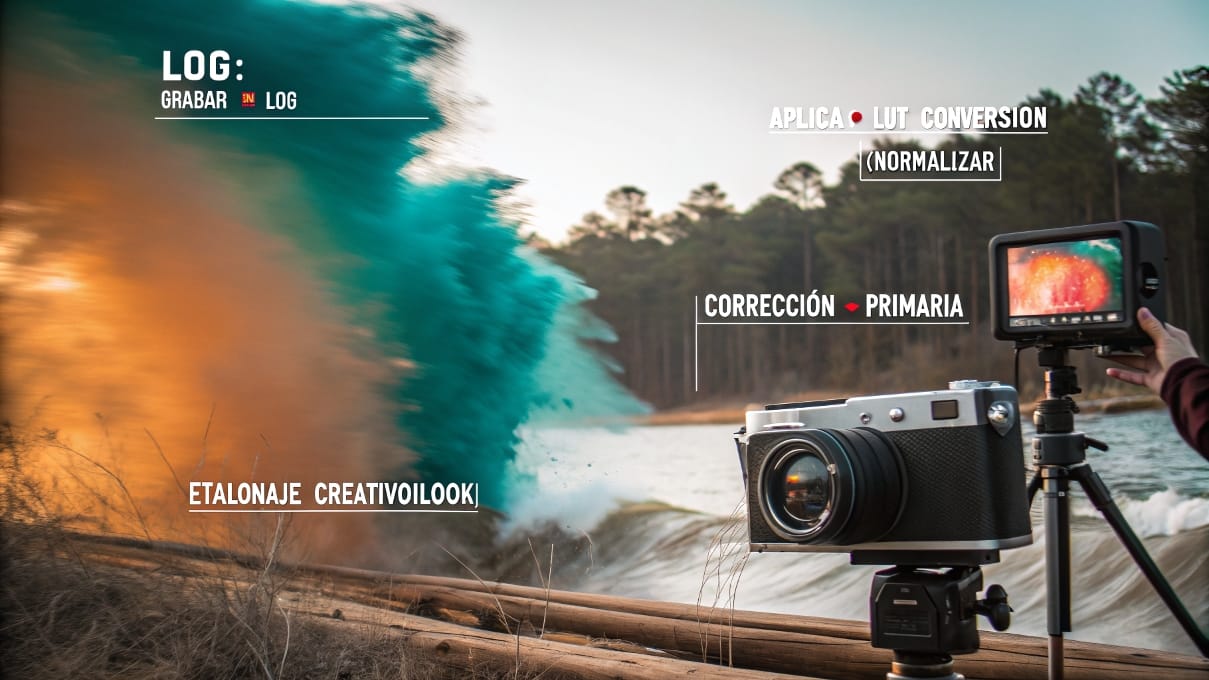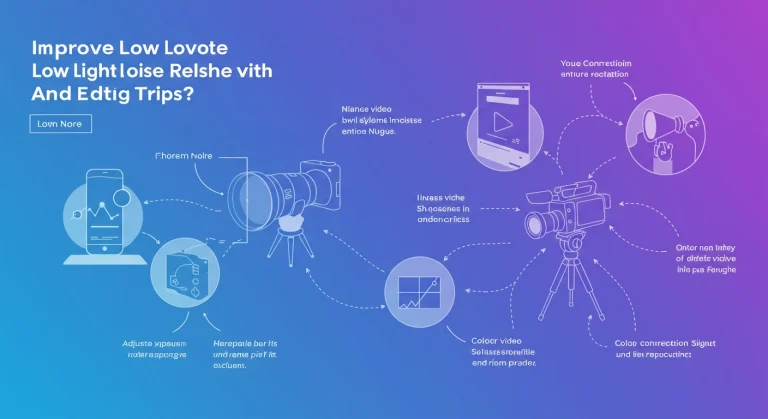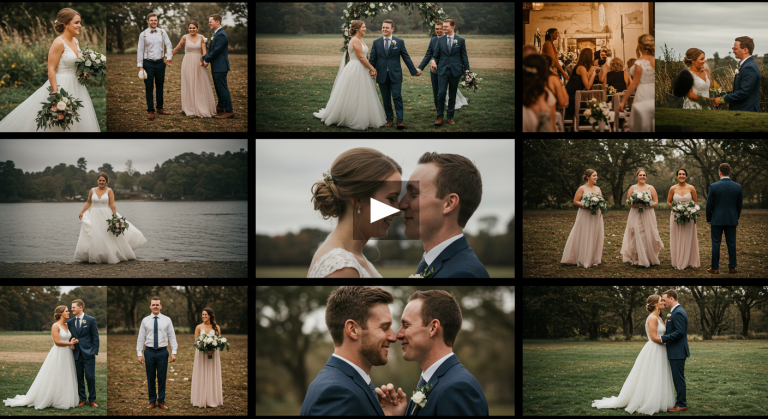Video Color Grading
🎬 From Correct to Cinematic
Your videos already have correct and consistent colors—excellent! But how do you go from a “correct” image to one that truly conveys atmosphere, style, or a particular emotion? Welcome to the world of color grading!
If you’ve followed our color journey, starting with basic color correction and understanding how to use creative LUTs as a starting point or inspiration, you’re now ready to explore color grading. While correction focuses on technical accuracy, color grading is the creative process of manipulating color to achieve aesthetic or narrative goals. It’s where you truly “paint” with light and color to give personality to your video.
At EdicionVideoPro, color grading is where the client’s vision and our experience merge to create a unique visual impact. You don’t have to be a Hollywood colorist to start applying basic color grading principles and significantly elevate the look of your projects, especially if you’ve worked with LOG footage that gives you more flexibility.
Quick Reminder ⚠️ Color Correction BEFORE Grading
🚫 We Can’t Emphasize This Enough!
Before thinking about giving your video a creative “look,” you must:
✅ Complete Primary Color Correction
Neutral white balance, correct exposure, adequate contrast, natural saturation.
🎯 Ensure Consistency (Shot Matching)
All your shots must look coherent with each other.
❌ Creative grading applied over poorly corrected footage will only magnify the problems. It’s like painting a dirty, hole-filled wall!
What Are We Looking For with Basic Color Grading?
Create a Visual “Look” or Style
Cinematic, vintage, modern, raw documentary, etc.
Establish Atmosphere or Mood
Warm tones for joy/nostalgia, cool for tension/sadness, desaturated for serious tone.
Direct Viewer Attention
Use color and light to highlight important elements in the frame.
Enhance Visual Narrative
Let color support the story you’re telling (e.g., different color palette for flashbacks).
Give Aesthetic Cohesion
Visually unify the entire project with a consistent color palette.
Essential Tools to Start Color Grading
Beyond basic correction controls, for color grading you’ll start using slightly more advanced tools. Don’t worry—we’ll go step by step!
🎡 Color Wheels: The Heart of Grading
🌑 Lift (Shadows)
Affects mainly dark areas. You can add color tints (e.g., blues in shadows for a “blockbuster” look).
🌗 Gamma (Midtones)
Affects mid-tones where most visual information is (including skin tones!).
☀️ Gain (Highlights)
Affects mainly bright areas. You can add tints (e.g., oranges in highlights).
📈 Curves: Powerful and Versatile
Luminance Curve (Luma Curve)
Allows precise contrast and brightness adjustments at different tonal range points (shadows, mids, highlights). A gentle “S-curve” usually adds pleasing contrast.
RGB Curves
Let you adjust luminance of each color channel (Red, Green, Blue) separately, or add/remove color in different parts of the tonal range.
S-Curve Example
Classic S-curve for contrast
🎨 HSL Color Selectors
Select specific colors (sky blue, leaf green, skin tones) and adjust only THAT color’s Hue, Saturation, or Luminance. Perfect for secondary corrections!
🔵 Vignettes
Subtly darken or brighten image edges to center attention on the main subject. Keep it subtle!
Basic Approach for Your First Color Grade
After your primary correction, here’s a possible workflow:
Establish Contrast with Curves
Use the Luminance Curve to create a gentle “S-curve”: lower shadows slightly, raise highlights slightly, adjust midpoint. This adds contrast and “depth” to the image.
Play with Color Wheels
Start adding subtle color tints in Lift, Gamma, and Gain. Popular “Teal & Orange” look: Add blue/cyan to shadows (Lift), orange/yellow to highlights (Gain).
Secondary Corrections with HSL
Need the sky bluer or grass greener without affecting skin tones? Use HSL selectors to target specific colors and adjust their Hue, Saturation, or Luminance.
Add Subtle Vignette
Want to direct attention to the center? Add a vignette that slightly darkens the edges. Keep it very subtle so it’s not too obvious!
Compare and Adjust
Use “before/after” or “bypass” functions to compare your grade with the original. Does it enhance the story? Save good looks as presets!
💡 EdicionVideoPro Pro Tip:
Be subtle! Small movements in the wheels can have big impact. Constantly watch your Scopes (Vectorscope for color balance, Waveform for exposure). Skin tones are SACRED—always keep them natural and healthy!
Inspiration and References Where to Get Ideas for Looks
Movies and TV Shows
Your best school! Analyze color palettes of your favorite films. What colors do they use? How’s the contrast? What emotion do they convey?
Photography
Many grading styles are inspired by photographic looks. Study portrait and landscape photography for color inspiration.
Painting and Art
Color palettes from great masters can be inspiration sources. Study how artists use color to convey emotion and mood.
Nature
Colors of sunset, forest, sea… Nature provides infinite color palette inspiration for your creative looks.
Online Tools
Sites like Adobe Color or Coolors let you explore and create color palettes. Perfect for planning your grading approach.
Common Mistakes in Basic Color Grading ⚠️ Watch Out!
❌ Skipping Primary Correction
We said it, but it’s mistake #1! Never apply creative looks over uncorrected footage.
🌈 Exaggerated Looks
Over-saturated colors, extreme contrasts that crush details, unrealistic skin tones. Subtlety is usually more effective!
🎭 Inconsistency
Different shots with completely different looks without narrative justification. Maintain visual coherence.
👤 Forgetting Skin Tones
Making skin look green, blue, or magenta. A big NO! Skin tones should always look natural and healthy.
📊 Not Using Scopes
Relying only on eyes on an uncalibrated monitor leads to errors. Scopes are your objective friend!
Frequently Asked Questions
Color as a Silent Storyteller
Basic color grading is where you start using color not just to “fix” the image, but to tell your story, evoke emotions, and create a distinctive visual style. It’s a fascinating field that combines technique and art.
Start with good correction, experiment with color wheels and curves subtly, pay attention to skin tones, and always seek for your grading to serve your video’s purpose.
Want Professional Cinematic Color Grading?
If you want your videos to have a truly professional look and a color palette that speaks for itself, the EdicionVideoPro team specializes in taking your projects’ color to the next level. Turn your vision into an impactful visual reality.
Get Professional Color Grading Free Color Consultation







One Comment